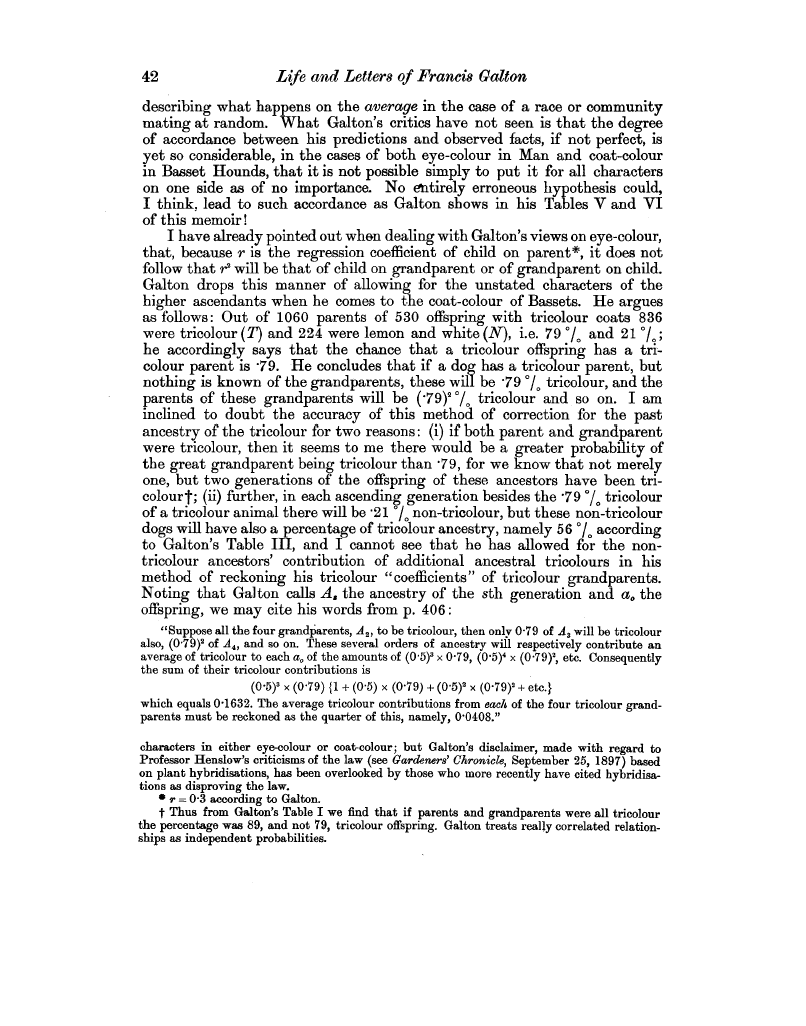| ||||||

OCR Rendition - approximate
42 Life and Letters of Francis Galton describing what happens on the average in the case of a race or community mating at random. What Galton's critics have not seen is that the degree of accordance between his predictions and observed facts, if not perfect, is yet so considerable, in the cases of both eye-colour in Man and coat-colour in Basset Hounds, that it is not possible simply to put it for all characters on one side as of no importance. No mtirely erroneous hypothesis could, I think, lead to such accordance as Galton shows in his Tables V and VI of this memoir ! I have already pointed out when dealing with Galton's views on eye-colour, that, because r is the regression coefficient of child on parent*, it does not follow that r2 will be that of child on grandparent or of grandparent on child. Galton drops this manner of allowing for the unstated characters of the higher ascendants when he comes to the coat-colour of Bassets. He argues as follows: Out of 1060 parents of 530 offspring with tricolour coats 836 were tricolour (T) and 224 were lemon and white (N), i.e. 79 °/o and 21 °/O; he accordingly says that the chance that a tricolour offspring has a tricolour parent is •79. He concludes that if a dog has a tricolour parent, but nothing is known of the grandparents, these will be •79 °/, tricolour, and the parents of these grandparents will be (-79)2'/. tricolour and so on. I am inclined to doubt the accuracy of this method of correction for the past ancestry of the tricolour for two reasons : (i) if both parent and grandparent were tricolour, then it seems to me there would be a greater probability of the great grandparent being tricolour than •79, for we know that not merely one, but two generations of the offspring of these ancestors have been tricolourt; (ii) further, in each ascending generation besides the •79 °/O tricolour of a tricolour animal there will be -21 °/o non-tricolour, but these non-tricolour dogs will have also a percentage of tricolour ancestry, namely 56 °/o according to Galton's Table III, and I cannot see that he has allowed for the nontricolour ancestors' contribution of additional ancestral tricolours in his method of reckoning his tricolour "coefficients" of tricolour grandparents. Noting that Galton calls A, the ancestry of the sth generation and ao the offspring, we may cite his words from p. 406: "Suppose all the four grandparents, A,, to be tricolour, then only 0.79 of A, will be tricolour also, (0.79)2 of A4f and so on. These several orders of ancestry will respectively contribute an average of tricolour to each a, of the amounts of (0-5)3x 0.79, (0.5)4 x (0.79)2, etc. Consequently the sum of their tricolour contributions is (0.5)3 x (0-79)11 + (0.5) x (0.79) + (0.5)2 x (0.79)2 + etc.} which equals 0.1632. The average tricolour contributions from each of the four tricolour grandparents must be reckoned as the quarter of this, namely, 0.0408." characters in either eye-colour or coat-colour; but Galton's disclaimer, made with regard to Professor Henslow's criticisms of the law (see Gardeners' Chronicle, September 25, 1897) based on plant hybridisations, has been overlooked by those who more recently have cited hybridisa tions as disproving the law. * r = 0.3 according to Galton. t Thus from Galton's Table I we find that if parents and grandparents were all tricolour the percentage was 89, and not 79, tricolour offspring. Galton treats really correlated relationships as independent probabilities.
|